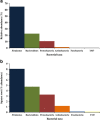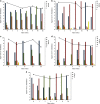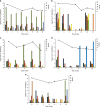Effect of exclusive enteral nutrition on the microbiota of children with newly diagnosed Crohn's disease
- PMID: 25588524
- PMCID: PMC4418409
- DOI: 10.1038/ctg.2014.21
Effect of exclusive enteral nutrition on the microbiota of children with newly diagnosed Crohn's disease
Abstract
Objectives: Exclusive enteral nutrition (EEN) is commonly used to treat pediatric Crohn's disease (CD). Meta-analysis of pediatric studies that have compared the effect of EEN with other treatments have shown that EEN induces remission in up to 80-85% of patients. We aimed to gain a comprehensive understanding of the effect of EEN on the microbiota of CD patients.
Methods: We used 16S rRNA gene and whole-genome high throughout sequencing to determine changes in the fecal microbiota of five CD children, before, during, and after EEN therapy and compared this with five healthy controls.
Results: The microbial diversity observed in CD patients tended to be lower than that in controls (CD: 2.25±0.24, controls: 2.75±0.14, P=0.11). In all CD patients, dysbiosis was observed prior to therapy. EEN therapy had a positive effect in all patients, with 80% going into remission. In some patients, the positive effect diminished following the conclusion of EEN therapy. Significantly, the number of operational taxonomic units (OTU) decreased dramatically upon starting EEN and this corresponded with CD remission. Recurrence of CD corresponded with an increase in OTUs. Six families within the Firmicutes were found to correlate with disease activity during and following EEN therapy, a finding that was confirmed by whole-genome high throughput sequencing.
Conclusions: Our results demonstrate that EEN leads to common and patient-specific alterations in the microbiota of CD patients, a number of which correlate with disease activity.
Figures





References
-
- Sartor RB. Mechanisms of disease: pathogenesis of Crohn's disease and ulcerative colitis. Nat Clin Pract Gastroenterol Hepatol. 2006;3:390–407. - PubMed
-
- Talley NJ, Abreu MT, Achkar JP, et al. An evidence-based systematic review on medical therapies for inflammatory bowel disease. Am J Gastroenterol. 2011;106:S2–25. - PubMed
-
- Heuschkel RB, Menache CC, Megerian JT, et al. Enteral nutrition and corticosteroids in the treatment of acute Crohn's disease in children. J Pediatr Gastroenterol Nutr. 2000;31:8–15. - PubMed
-
- Breese EJ, Michie CA, Nicholls SW, et al. The effect of treatment on lymphokine-secreting cells in the intestinal mucosa of children with Crohn's disease. Aliment Pharmacol Ther. 1995;9:547–552. - PubMed
-
- Day AS, Whitten KE, Lemberg DA, et al. Exclusive enteral feeding as primary therapy for Crohn's disease in Australian children and adolescents: a feasible and effective approach. J Gastroenterol Hepatol. 2006;21:1609–1614. - PubMed
LinkOut - more resources
Full Text Sources
Other Literature Sources

